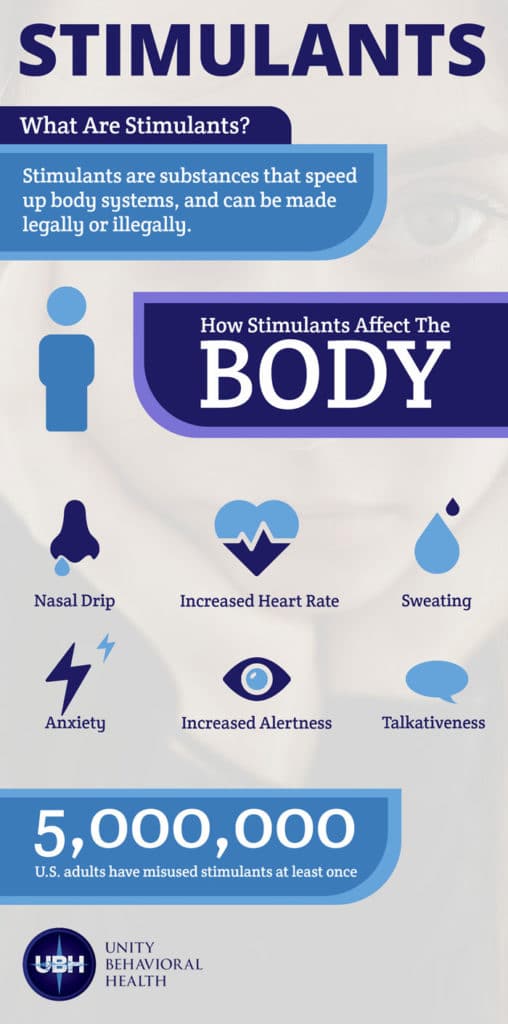When people think of drugs, they don’t think of their favorite breakfast beverage. Though, drinks, food, and “natural pills” can contain an ingredient that is considered a stimulant drug. Not every stimulant drug leads to withdrawal.
There are types of stimulant drugs that are used for health reasons. On the other hand, these prescription stimulants might lead someone to need stimulant addiction treatment. Legal or illegal, stimulant drugs can help or hinder those who use them.
What Are Stimulants?
Stimulants are substances that speed up body systems, according to the Drug Enforcement Administration (DEA). This drug abuse help site says they are made both legally and illegally. Some are prescription stimulants. Others are made for illicit use. Many stimulants are natural.
Above all, stimulants have the same overall effect. They affect the nervous system. To clarify, they increase levels of the body’s chemicals for a desirable outcome making it one of the most popular types of substances for drug abuse.
Stimulant drugs generally affect the body in these ways:
- Make someone feel more awake and alert
- Euphoria
- May cause people to be chatty
- Clenched teeth or teeth grinding
- Nasal drip
- Increased blood pressure and heart rate
- Can improve concentration
- Can make someone overly-confident
- Might make a person overly-friendly and trusting
- Sweating more than usual
- Anxiety
- No appetite
Everyone reacts to drugs differently and symptoms or signs that it is getting bad may differ. Doctors can predict the outcome. Drug dealers can’t. There is no guarantee of what can happen with stimulant drug abuse. In short, this makes them dangerous.
Causes and risk factors for stimulant abuse
There are a number of possible causes and risk factors for stimulant abuse. Some individuals may be more vulnerable to developing stimulant addiction due to their genetic makeup or family history. Researchers have discovered genetic traits in twin identical individuals that could influence how people develop drug abuse. Some new research is already being conducted to identify some possible genetic factors that can contribute to this risk.
Additionally, those who have easy access to stimulants or who associate with others who abuse drugs may be more likely to develop an addiction.
For some, stimulant abuse starts because they want to improve their academic or athletic performance. Others may abuse stimulants to lose weight or combat fatigue. Another risk factor is that some people may abuse stimulants because they are addicted to the way the drugs make them feel.
People who abuse stimulants may do so because they are trying to self-medicate for underlying mental health issues such as depression or anxiety. Stimulant abuse can also be a way to cope with trauma or stress.
Signs and symptoms of stimulant abuse
Stimulants can be very addictive, and people who use them can develop tolerance quickly, needing more and more of the drug to get the same effect and plunging deep into drug abuse each time. Signs and symptoms of stimulant abuse can vary depending on the type of stimulant involved, how much is being used, and the individual. However, there are some severe signs and symptoms that may be present when someone has stimulant addiction versus the general effects of just using a stimulant that was mentioned above.
- Dilated pupils
- Chills
- Nausea or vomiting
- Tremors or twitching
- Seizures (in severe cases)
- Agitation or irritability
- Paranoia or delusions
- Violent or aggressive behavior
- Psychosis (in severe cases)
GET HELP TODAY
Overcoming an addiction from substances or alcohol can be a very hard journey, and it’s important to have a trusted facility and staff by your side while you do it. Behavioral Health Centers is here to offer all our resources so you can live a happier and healthier life.
The Science Behind Stimulants
To begin, the brain interacts with stimulants the most. Yet, this drug affects more parts of the body. Firstly, it needs to make its way into the body.
There are multiple ways to ingest stimulants
- Swallowing
- Snorting
- Inhaling
- Injection
When swallowed, stimulants make their way into the intestinal tract and stomach. After, it’s broken down by the digestive tract. Some elements enter the bloodstream. The ones in the bloodstream give people physical and mental sensations. Other parts are digested.
Snorted stimulants stick to the nasal passages. Then, they absorb directly into the bloodstream. Typically, legal stimulants aren’t snorted.
On the other hand, inhaled stimulants enter the lungs as a gas. The lungs are a large area for the gas to enter the bloodstream. Similarly, it’s rare to take legal stimulants this way.
Finally, they can also be injected directly into the bloodstream much like other prescription drugs that are being abused. Once stimulants are in the bloodstream, they engage with multiple organs and organ systems. Chemical signals tell the brain to make a person feel a certain way. They speed up neural activity.
What is Stimulant Withdrawal?
Withdrawal is common for all drug abuse patients who want to stop. A stimulant withdrawal is a physical and mental reaction to a lack of chemicals stimulants induce. The chemical signals stimulants that fire off are neurotransmitters. Dopamine and serotonin are types of these. They make people feel happy and calm.
Stimulants override the production of these chemicals. So, their body becomes dependent on drugs for that emotion. Once they stop stimulant drug abuse, their body freaks out. Its chemicals are depleted. The body screams for more but gets none.
Signs and Symptoms of Stimulant Withdrawal
- Bodily aches and pains
- Irritability and anger
- Seizures
- Depression
- Anxiety
- Disrupted sleep
- Random chills
- Memory issues
Withdrawal from stimulants, prescription drugs or illegal drugs, is uncomfortable. At times, they are deadly. Signs and symptoms might last for 2 weeks. If they go beyond that, they are classified as post-acute-withdrawal symptoms (PAWS).
What is Considered a Stimulant Drug?
A person who uses stimulants might need it for health reasons. Another might drink a cup of stimulants every morning to wake up. Unfortunately, many may use it at a party or bar for fun. All of these may lead to stimulant drug abuse. The National Institute on Drug Abuse (NIDA) found that about 5 million Americans abuse prescription stimulants every year. Around half a million had casual use turn into substance abuse problems.
To continue, pharmaceutical companies make prescription stimulants. Farmers also make them. Some criminals make them in illicit labs. In other words, there is a large range of stimulant drugs.
Types Of Stimulants
Food and Drinks
It might come as a shock that stimulant drugs can be bought at restaurants. Caffeine is considered a stimulant drug. Guarana, an ingredient in many energy drinks, is considered a stimulant drug as well. That boost of energy comes from the science behind stimulants.
Here are a few (delicious) examples:
- Coffee
- Green tea
- Black tea
- Energy drinks (Monster, Redbull, and Rockstar are popular ones)
- Desserts and candy made with matcha
- Dark chocolate
- Soda
These tasty treats don’t usually cause ill effects or serious mental disorders. However, they contain a stimulant. This puts people at risk for withdrawal.
For example, those who indulge in a daily cup of Starbucks may experience slight withdrawal. Coffee makes them feel energetic. Going cold-turkey to caffeine can mean grogginess and irritability.
Additionally, some may have adverse reactions. Someone with an anxiety disorder can have a panic attack because of too much caffeine. Even black tea can make certain individuals feel anxious.
Over the Counter (OTC)
Additionally, people use over-the-counter (OTC) stimulants. OTC stimulants are usually packed with caffeine and guarana. Those who want more energy or deeper concentration might turn to these. They might feel that because it isn’t medicine per se, it’s better for them, however too much of these also lead to stimulant drug abuse.

Forms of OTC stimulants are:
- Energy-boosting pills
- OTC study drugs
- Diet pills
Since they aren’t illegal or prescribed, they avoid scrutiny. Research lacks a focus on OTC stimulant abuse. Yet, some research suggests that people can have a withdrawal from them.
Prescription Drugs
A study by NIDA found that around 16 million Americans were prescribed stimulants in 2015. That’s about 6.6% of the USA’s population using stimulant prescription drugs. So, prescription stimulants can change people’s lives for the better.
People that have diagnosable attention-deficit/hyperactivity disorder (ADHD) can get stimulant prescriptions.
These stimulants are typically prescribed to people with ADHD:
- Dextroamphetamine (Adderall XR)
- Methylphenidate (Concerta, Ritalin, Daytrana)
- Amphetamine/dextroamphetamine combos (Adderall)
- Amphetamine sulfate (Evekeo)
- Dexmethylphenidate (Focalin)
- Lisdexamfetamine (Vyvanse)
In summary, there are a slew of other prescription stimulants to treat attention deficit hyperactivity disorder. People with ADHD can have normal lives with medications like these.
The Centers for Disease Control and Prevention (CDC) found 6.1 million American kids had attention deficit hyperactivity disorder. This data from 2016 shows that about 9.4% of children were surveyed. Without prescription drug stimulants, they may not be able to sit still, take a test, or even hold a normal conversation.
Yet, some abuse prescription stimulants. Students from middle school to doctorate illegally take them. As a result, they can get an addiction or even overdose. According to a new study, prescription drug stimulant use has grown among young adults in the United States over the past decade, with the prevalence rising from 0.7% to 2.1%. These findings suggest that the increase in stimulant prescription drugs use disorder is a public health concern
Illegal
There are types of stimulants that are illegal or not prescription medications. They are made illicitly. Then, they are distributed in secret. There are studies out there to use illegal stimulants for medical reasons. Yet, they are not legal as of now.
Stimulants that are street drugs come in different forms:
- Cocaine (coke)
- Crystal meth
- Ecstasy
- Speed
- Crack
- Bath salts
A rush of euphoria comes from these illegal stimulants. Stimulant abusers use them to keep them awake and dancing at clubs.
Consequently, they don’t think about how their casual use can end them at a drug abuse and addiction treatment center. Constant use of stimulants like these can deplete bodily chemicals that make people happy and calm. Even worse, stimulant abusers can die from them or become suicidal/homicidal.
Who Should Consider Stimulant Addiction Treatment?
There are types of stimulants that are illegal or not prescription medications. They are made illicitly. Then, they are distributed in secret. There are studies out there to use illegal stimulants for medical reasons. Yet, they are not legal as of now.
Stimulants that are street drugs come in different forms:
- Cocaine (coke)
- Crystal meth
- Ecstasy
- Speed
- Crack
- Bath salts
A rush of euphoria comes from these illegal stimulants. Stimulant abusers use them to keep them awake and dancing at clubs.
Consequently, they don’t think about how their casual use can end them at a drug abuse and addiction treatment center. Constant use of stimulants like these can deplete bodily chemicals that make people happy and calm. Even worse, stimulant abusers can die from them or become suicidal/homicidal.

What to Expect At a Stimulant Addiction Treatment Center
At addiction treatment centers, people suffering from substance use disorders and mental health issues have options. They are probably not going in for coffee. It’s more likely they’ll go in for a dependency on illegal stimulants or prescribed ones.
They’ll work with a team of medical professionals and counselors. In doing so, they can craft a plan that works best for them. During onboarding, patients can expect to find out a general timeline of recovery. Additionally, they can go through a list of treatment programs that are most suitable for them.
Also, patients will work with medical professionals to address underlying physical and mental health issues. Only addressing one issue will impede stimulant addiction recovery. Aftercare will also be up for discussion. A comprehensive plan is one that will work.
Types of Stimulant Addiction Treatment
Effective treatment depends on personal factors. What is the severity of their stimulant addiction? How much time can they dedicate to recovery? How much money can they spend on it? A stimulant rehabilitation center may consider different types of treatment depending on the answers.
Talk Therapy
Talk therapy is a proven method to enforce positive behavior for substance abuse patients. A patient might speak to a therapist or counselor about obstacles to recovery. Popular forms of talk therapy include dialectical behavioral therapy (DBT) and cognitive-behavioral therapy (CBT).
Medical Detox
If stimulant addiction is severe, a person suffering from it may need to go through medical detox. This would happen before treatment. Medical and mental health experts will prescribe medication to help the withdrawal symptoms. Additionally, they might be prescribed medication to help with mental illness.
Outpatient Programs
Outpatient treatment for substance abuse can be an effective way to help people struggling with addiction but can’t commit to an inpatient program yet. It can provide them with the support they need to recover, while also allowing them to maintain their everyday lives.
There are many different types of outpatient treatment programs, and the one that’s right for someone will depend on their individual needs. Some programs may require people to come in for substance abuse and mental health treatment a few times a week, while others may only require attendance once or twice a month.
Inpatient Treatment
Inpatient substance abuse treatment is usually done in a hospital setting, where patients can be monitored around the clock to ensure their safety and well-being. Inpatient treatment typically lasts for 30 days, though some programs may last 60 days or more.
During inpatient treatment, patients will participate in group and individual therapy sessions, as well as other activities designed to help them recover from their addiction and mental health disorder. After completing inpatient treatment, patients may need to participate in an outpatient treatment program to help them maintain their sobriety.
Inpatient treatment for substance abuse can be very effective, as it allows patients to focus solely on their recovery.
Behavioral Health Centers Can Help With Stimulant Withdrawal
Behavioral Health Centers works with a team of experienced medical and mental health professionals to provide the best treatment for stimulant abuse, other substance abuse and mental health issues. We know that addiction doesn’t look a certain way. It also doesn’t affect a certain person. It affects everyone around them, too.
Contact us now if you or someone you care about needs help with addiction recovery. There is no shame in getting help. It’s only a shame if you never get help.
GET HELP TODAY
Overcoming an addiction from substances or alcohol can be a very hard journey, and it’s important to have a trusted facility and staff by your side while you do it. Behavioral Health Centers is here to offer all our resources so you can live a happier and healthier life.







